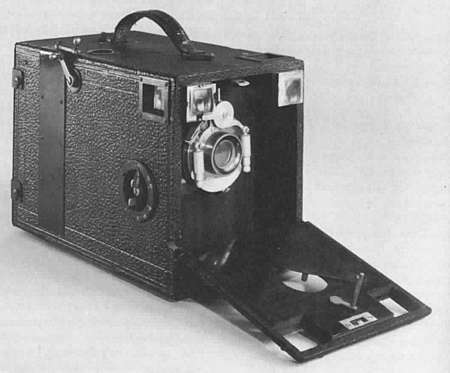| ILFORD Falling Plate |
 |
||
|
|
||
|
This quarter plate magazine 'box' camera was advertised as able to be loaded in less than a minute with sufficient cut film to take 40 exposures before needing a reload. Ilford manufactured their own special film with a cardboard backing. The illustration above is the ILFORD Falling Plate camera, as shown within the book 'Silver by the Ton - A History of Ilford Limited 1879-1979' by RJ Hercock and GA Jones. The publishers are McGraw Hill, the ISBN is 0-07-084525-5. This source is unreservedly acknowledged. Quoting from that book (relevant to the end of the 19th & start of 20th centuries): "Roll-film cameras were
looked upon with disdain by serious photographers - the snapshot
hobby was a frivolity - though plate cameras were recognized
to be heavy and clumsy. R.and J. Beck had brought out the Frena
camera (an acronym meaning: 'For Rapidly Exposing Negatives Automatically'),
holding forty notched sheets of film in a magazine, and Ilford
did make flat films for it for a time. These cameras were made
in Germany, where the move towards mass-produced hand cameras
was starting, although the UK made the best brass-bound mahogany
cameras. The remaining pictures of the Falling Plate camera were taken by me in the South Kensington Science Museum during November 2005. The camera is probably now in the National Media Museum, Bradford, West Yorkshire, BD1 1NQ (Inventory Number 1976 - 537). The camera was behind glass, which explains the reflections. I would like to acknowledge assistance by Andy Holliman and David Gardner in understanding the working of the Falling Plate camera. Also, the close up of the lens and Unicum shutter (below) is by David Gardner. The camera was meant to be operated with the front flap door hinged closed (upwards). The vertical lever 'stick' above the shutter, which cocks it, is operable with the front closed, and focussing is via the side knob. The speed and aperture were presumably set beforehand. The shutter is designed to be fired either by a pneumatic release or by the manual lever. A pneumatic release (consisting of a rubber bulb and length of tubing) would have applied pressure to the left (as we look at it) shutter cylinder, forcing up an internal piston which released the shutter 'catch' which had been holding the shutter in tension. The right piston acts as a retarding brake for the slow speeds. The access hole to the front lower LHS of the camera 'box' would be unobscured with the front closed and gave access for the rubber tube. The pressure bulb would be held in the hand. |
 Above is a 1904 advertisement for the Falling Plate camera, taken from the British Journal Photographic Almanac (BJPA). The prices of the camera and its film packs can be read from this advert. |
This camera is probably now in the National Media Museum, Bradford, West Yorkshire, BD1 1NQ (Inventory Number 1976 - 537). It has the Bausch & Lomb lens and Unicum shutter. |
| Below is the description
given to the camera by the South Kensington Science Museum when
the camera was in London. |
 Close up of the Bausch & Lomb Rapid Rectilinear lens and Unicum shutter (1sec to 1/100th sec plus Bulb & Time exposures). Note: this illustration is taken from another camera but the lens and shutter assembly are believed to have originated on an ILFORD Falling Plate. |
|
A rear three quarters view. |
|
|
|
|
|
|
|